高三英语语法-倒装句
- 格式:doc
- 大小:53.50 KB
- 文档页数:5
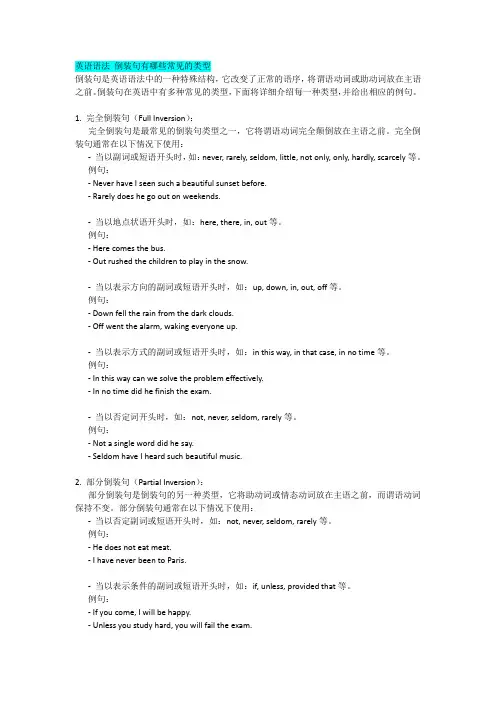
英语语法倒装句有哪些常见的类型倒装句是英语语法中的一种特殊结构,它改变了正常的语序,将谓语动词或助动词放在主语之前。
倒装句在英语中有多种常见的类型,下面将详细介绍每一种类型,并给出相应的例句。
1. 完全倒装句(Full Inversion):完全倒装句是最常见的倒装句类型之一,它将谓语动词完全颠倒放在主语之前。
完全倒装句通常在以下情况下使用:-当以副词或短语开头时,如:never, rarely, seldom, little, not only, only, hardly, scarcely等。
例句:- Never have I seen such a beautiful sunset before.- Rarely does he go out on weekends.-当以地点状语开头时,如:here, there, in, out等。
例句:- Here comes the bus.- Out rushed the children to play in the snow.-当以表示方向的副词或短语开头时,如:up, down, in, out, off等。
例句:- Down fell the rain from the dark clouds.- Off went the alarm, waking everyone up.-当以表示方式的副词或短语开头时,如:in this way, in that case, in no time等。
例句:- In this way can we solve the problem effectively.- In no time did he finish the exam.-当以否定词开头时,如:not, never, seldom, rarely等。
例句:- Not a single word did he say.- Seldom have I heard such beautiful music.2. 部分倒装句(Partial Inversion):部分倒装句是倒装句的另一种类型,它将助动词或情态动词放在主语之前,而谓语动词保持不变。
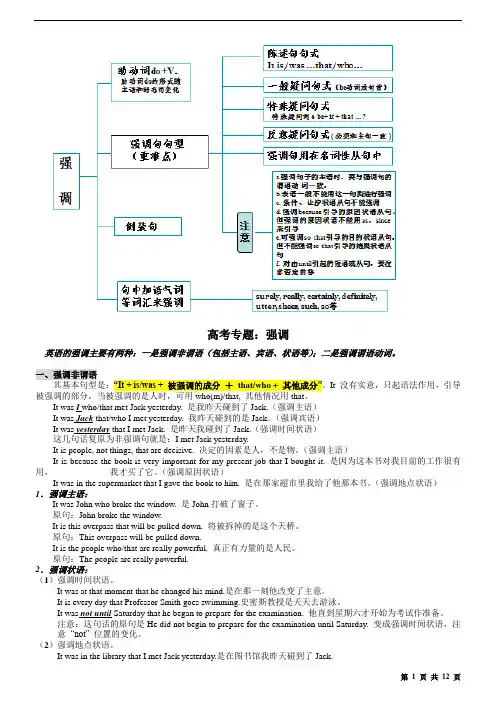
高考专题:强调英语的强调主要有两种:一是强调非谓语(包括主语、宾语、状语等);二是强调谓语动词。
一、强调非谓语其基本句型是:“It + is/was + 被强调的成分+that/who + 其他成分”。
It 没有实意,只起语法作用,引导被强调的部分。
当被强调的是人时,可用who(m)/that, 其他情况用that。
It was I who/that met Jack yesterday. 是我昨天碰到了Jack.(强调主语)It was Jack that/who I met yesterday. 我昨天碰到的是Jack。
(强调宾语)It was yesterday that I met Jack. 是昨天我碰到了Jack.(强调时间状语)这几句话复原为非强调句就是:I met Jack yesterday.It is people, not things, that are decisive. 决定的因素是人,不是物。
(强调主语)It is because the book is very important for my present job that I bought it. 是因为这本书对我目前的工作很有用,我才买了它。
(强调原因状语)It was in the supermarket that I gave the book to him. 是在那家超市里我给了他那本书。
(强调地点状语)1.强调主语:It was John who broke the window. 是John打破了窗子。
原句:John broke the window.It is this overpass that will be pulled down. 将被拆掉的是这个天桥。
原句:This overpass will be pulled down.It is the people who/that are really powerful. 真正有力量的是人民。
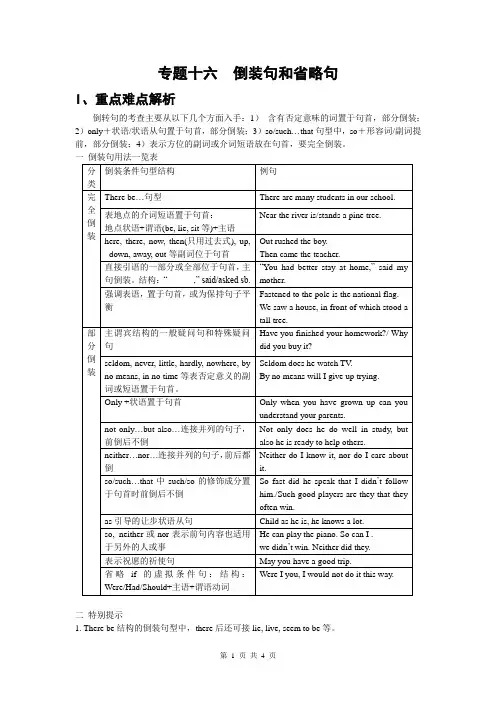
专题十六倒装句和省略句I、重点难点解析倒转句的考查主要从以下几个方面入手:1)含有否定意味的词置于句首,部分倒装;2)only+状语/状语从句置于句首,部分倒装;3)so/such…that句型中,so+形容词/副词提前,部分倒装;4)表示方位的副词或介词短语放在句首,要完全倒装。
二特别提示1. There be结构的倒装句型中,there后还可接lie, live, seem to be等。
例如:There lived an old man in the village long long ago.2. here, there, now, then(只用过去式), up, down, away, out等副词位于句首,主语为代词时不倒装。
例如:Out he rushed.3. 直接引语的一部分或全部位于句首,主句倒装。
但是主语为代词时不倒装。
“You had better stay at home,” she said.4. So位于句首不倒装的情况:主语与前句相同,表赞同, 译为“确实如此”。
例句:---Mike studies hard.---So he does. (确实是。
) 比较: (---So do I .我也是。
)5. 表示前句内容也适用于另外的人或事,前句如果列举了两种事实以上,用“So it is/waswith sb/sth.”回答。
---Tom is kind and often helps those in trouble.---So it is with his father.省略句高考命题导向:省略是一种避免重复,保持简洁的语法手段。
缺少一个或一个以上的必要语言成分,但在一定语境中能够独立存在,意义明确,并且能发挥交际功能的句子叫做省略句。
高考主要是考查省略在固定结构中的运用。
省略句用法一览表II、实战演练根据括号中的提示完成句子。
1.Not until __________________ (I; shout) at the top of my voice ________________ (he; turn) his head.2.I won the prize at last. Never in my life ___________________ (I; feel) so happy.3.Hardly _____________________ (the thief; see) the police ___________ he ran away.4.---Hurry up! There _______________________ ( the bell; go).---My goodness! Has Mrs Li come yet?---Look! Here ___________________ (he; come)5.Not only ___________________ (he; like) singing, but __________________ (he; have)a good voice.6.---David has passed the final exam smoothly.---So _________________ (he; have), and ___________________ (I, have).7.So ____________________ (he; be frightened) in the darkness that he did not dare to move an inch.8.Up _________________________ (the balloon; go) into the air.9.At the foot of the mountain _________________________ (a village; lie)10.I’v tried very hard to improve my English. But by no means _______________________ (the teacher, be satisfied) with my progress.11.If Joe’s wife doesn’t go to the party, neither ______________________.(他也不去)12.Should _________________________ (如果明天下雨), we would have to put off the sports meet.13.Child __________________ (尽管只是孩子), he shows great consideration towards the others.14.---Mike hadn’t passed the exam and was afraid of being scolded.--- ________________________. (我也一样)15.________________________________ (我们一听到铃声) than we rushed into the classroom.16.---He hasn’t finished the work yet.---Well, he _________________.(本该完成)17.The man we followed suddenly stopped and looked as if _______________ (see) whether he was going in the right direction.18.---Is your mother a teacher?---No, but she __________________.(过去是)19.---Do you know Anna’s telephone number?--- _______________ .(恐怕不知) As a matter of fact, I don’t know any Anna, either.20.---Who should be responsible for the accident?---The boss, not the workers. They just carried out the order ____________ (按被告诉的).答案:1. I shouted; did he turn 2. have I felt 3. had the thief seen; when 4. goes the bell; he comes 5. does he; he has 6. he has; so have I 7. frightened was he8.went the balloon 9. lies a village 10. is the teacher satisfied 11. will he 12. it rain tomorrow 13. as/though he is 14. So it was with me. 15. No sooner had we heard the ring 16. should/ought to have 17. to see 18. used to be 19. I’m afraid not 20. as told。
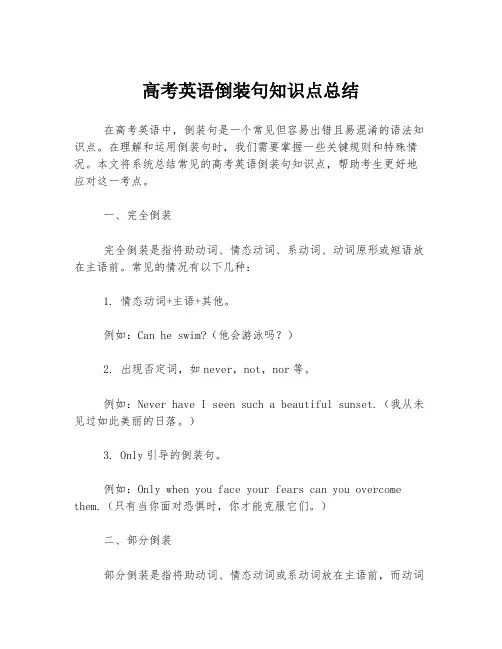
高考英语倒装句知识点总结在高考英语中,倒装句是一个常见但容易出错且易混淆的语法知识点。
在理解和运用倒装句时,我们需要掌握一些关键规则和特殊情况。
本文将系统总结常见的高考英语倒装句知识点,帮助考生更好地应对这一考点。
一、完全倒装完全倒装是指将助动词、情态动词、系动词、动词原形或短语放在主语前。
常见的情况有以下几种:1. 情态动词+主语+其他。
例如:Can he swim?(他会游泳吗?)2. 出现否定词,如never,not,nor等。
例如:Never have I seen such a beautiful sunset.(我从未见过如此美丽的日落。
)3. Only引导的倒装句。
例如:Only when you face your fears can you overcome them.(只有当你面对恐惧时,你才能克服它们。
)二、部分倒装部分倒装是指将助动词、情态动词或系动词放在主语前,而动词原形放在主语后。
常见的情况有以下几种:1. 祈使句倒装。
例如:Open the window, please.(请打开窗户。
)2. So引导的倒装句。
例如:He was late for the meeting, so was I.(他迟到了会议,我也是。
)3. 强调句倒装。
例如:It was in Paris that I met my true love.(我在巴黎遇到了我的真爱。
)三、介词短语倒装在以介词短语开头的句子中,常常用倒装结构来强调一些信息。
例如:Out of the classroom ran the excited children.(兴奋的孩子们跑出了教室。
)四、条件句倒装在条件句中,如果主句表达的是命令、建议、要求或愿望,那么条件句中即使是虚拟语气的情况下,也要采用部分倒装。
例如:Should you need any assistance, please feel free to contact us.(如果你需要任何帮助,请随时联系我们。
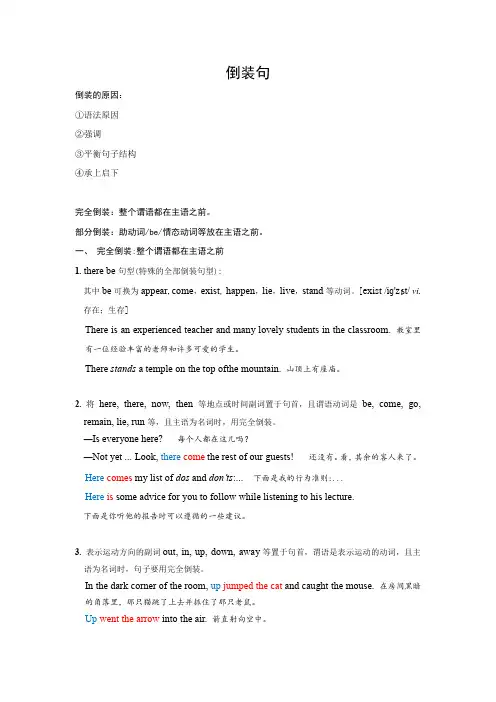
倒装句倒装的原因:①语法原因②强调③平衡句子结构④承上启下完全倒装:整个谓语都在主语之前。
部分倒装:助动词/be/情态动词等放在主语之前。
一、完全倒装:整个谓语都在主语之前1. there be句型(特殊的全部倒装句型):其中be可换为appear, come,exist, happen,lie,live,stand等动词。
[exist/iɡ'zɪst/ vi.存在;生存]There is an experienced teacher and many lovely students in the classroom. 教室里有一位经验丰富的老师和许多可爱的学生。
There stands a temple on the top ofthe mountain. 山顶上有座庙。
2. 将here, there, now, then等地点或时间副词置于句首,且谓语动词是be, come, go, remain, lie, run等,且主语为名词时,用完全倒装。
—Is everyone here? 每个人都在这儿吗?—Not yet ... Look, there come the rest of our guests! 还没有。
看,其余的客人来了。
Here comes my list of dos and don’ts:... 下面是我的行为准则:...Here is some advice for you to follow while listening to his lecture.下面是你听他的报告时可以遵循的一些建议。
3. 表示运动方向的副词out, in, up, down, away等置于句首,谓语是表示运动的动词,且主语为名词时,句子要用完全倒装。
In the dark corner of the room, up jumped the cat and caught the mouse. 在房间黑暗的角落里,那只猫跳了上去并抓住了那只老鼠。
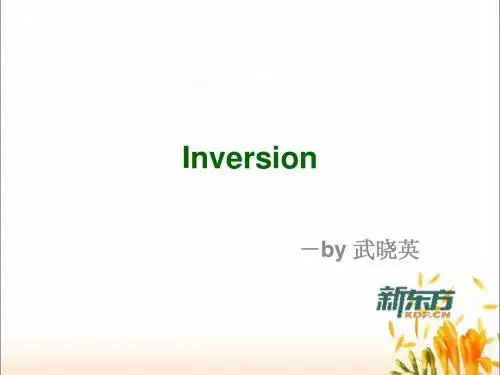
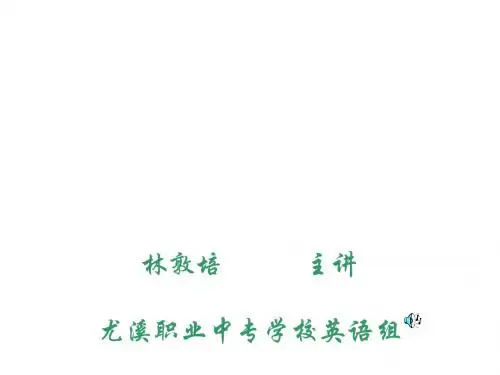
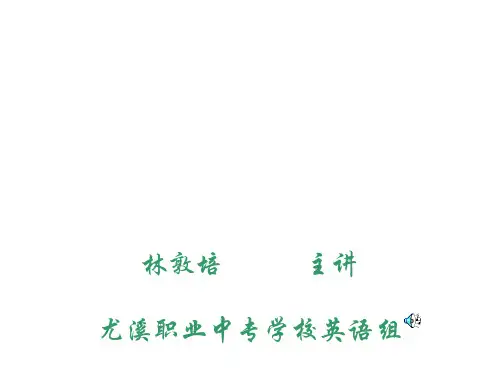
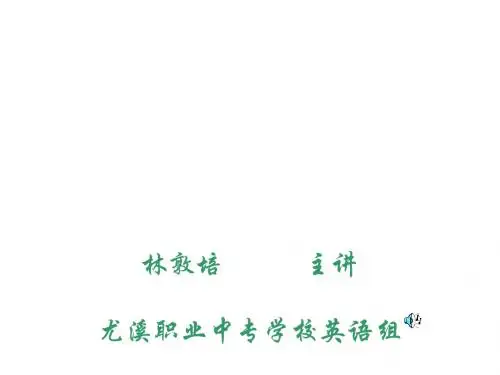
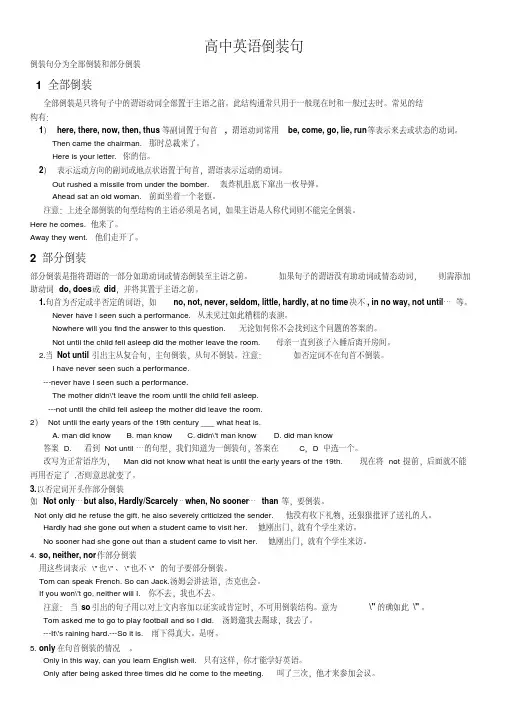
高中英语倒装句倒装句分为全部倒装和部分倒装1 全部倒装全部倒装是只将句子中的谓语动词全部置于主语之前。
此结构通常只用于一般现在时和一般过去时。
常见的结构有:1)here, there, now, then, thus等副词置于句首, 谓语动词常用be, come, go, lie, run等表示来去或状态的动词。
Then came the chairman. 那时总裁来了。
Here is your letter. 你的信。
2)表示运动方向的副词或地点状语置于句首,谓语表示运动的动词。
Out rushed a missile from under the bomber. 轰炸机肚底下窜出一枚导弹。
Ahead sat an old woman. 前面坐着一个老妪。
注意:上述全部倒装的句型结构的主语必须是名词,如果主语是人称代词则不能完全倒装。
Here he comes. 他来了。
Away they went. 他们走开了。
2 部分倒装部分倒装是指将谓语的一部分如助动词或情态倒装至主语之前。
如果句子的谓语没有助动词或情态动词,则需添加助动词do, does或did,并将其置于主语之前。
1.句首为否定或半否定的词语,如no, not, never, seldom, little, hardly, at no time决不, in no way, not until…等。
Never have I seen such a performance. 从未见过如此糟糕的表演。
Nowhere will you find the answer to this question. 无论如何你不会找到这个问题的答案的。
Not until the child fell asleep did the mother leave the room. 母亲一直到孩子入睡后离开房间。
2.当Not until引出主从复合句,主句倒装,从句不倒装。

高中英语倒装句语法知识汇总-CAL-FENGHAI.-(YICAI)-Company One1高中英语倒装句语法知识汇总一.概念:英语句子通常有两种语序:一种主语在前,谓语在后,称为自然语序,另一种谓语在前,主语在后,称为倒装语序。
二.相关知识点精讲按“主语+ 谓语” 这种顺序排列的句子是陈述语序。
如果排列顺序变为“谓语(或谓语一部分)+主语”,就是倒装。
倒装句分为:完全倒装:整个谓语移至主语前面叫完全倒装。
部分倒装:只把助动词、系动词或情态动词放在主语之前叫部分倒装。
1. 当以there, here, out , in , up , down, away 等副词开头的句子,为了起到强调的作用,可构成倒装句,只把副词放在句首,主语和谓语位置调换,不加助动词。
Our teacher came in. In came our teacher.这种倒装要求:主语必须是名词。
主语是人称代词时,主语和谓语语序不变。
Here it is. Away he went.这类倒装句式一般只用一般现在时和一般过去时。
Here comes the bus. Out rushed the boys.2. how, then, just, often 表示时间的副词放在句首,可构成倒装句,只把副词放在句首,主语和谓语位置调换,不加助动词。
Then came 8 years of the Anti Japanese War.3. 表地点状语的介词短语放在句首,要用倒装句式,以示强调。
这种倒装句也是主谓直接调换位置,不加助动词did, does或do.Under a big tree ________, half asleep.A. did sat a fat manB. a fat man satC. did a fat man satD. sat a fat man4. there放在句首时,要用倒装句式。
在“there + be”结构中的谓语动词有时不用be , 而用表示类似“存在”观念的其他不及物动词。
高中英语倒装句倒装句分为全部倒装和部分倒装1全部倒装全部倒装是只将句子中的谓语动词全部置于主语之前。
此结构通常只用于一般现在时和一般过去时。
常见的结构有:1)here, there, now, then, thus等副词置于句首, 谓语动词常用be, come, go, lie, run等表示来去或状态的动词。
例如:Then came the chairman. 那时总裁来了。
Here is your letter. 你的信。
2). up,down,out,away,in , off, ahead放于句首Up jumped the cat and caught the mouse.Ahead sat an old woman.3)表示地点,时间,方向等的介词短语放在句首时例如:After the head walked a group of workers.4.“作表语的现在分词/过去分词/形容词+系动词+主语”形式的完全倒装Seated in the front were the guests.注意:上述全部倒装的句型结构的主语必须是名词,如果主语是人称代词则不能完全倒装。
例如:Here he comes. 他来了。
Away they went. 他们走开了。
2部分倒装部分倒装是指将谓语的一部分如助动词或情态倒装至主语之前。
如果句子的谓语没有助动词或情态动词,则需添加助动词do, does或did,并将其置于主语之前。
1. 句首为否定或半否定的词语,如no, not, never, seldom, little, hardly, rarely, scarely, in no way, under no circumstance, at no time决不, not until…等。
例如:Never have I seen such a performance. 从未见过如此糟糕的表演。
Nowhere will you find the answer to this question. 无论如何你不会找到这个问题的答案的。
倒装句 英语句子通常是主语在前,谓语动词在后。但如果谓语动词出现在主语之前,这种现象叫倒装。部分倒装和全部倒装是专对主语和谓语而言的。谓语的一部分(助动词,情态动词)移到主语之前,而谓语的其余部分(实义动词)仍保留在主语之后,这种主谓倒装叫做部分倒装(Partial inversion)。谓语的所有组成部分都移到主语之前的则称为全部倒装(Complete inversion)。部分倒装句式里是语法上的强制要求,而完全倒装则是出于修辞上的需要,是为了强调主语(使主语占据句尾信息焦点的位置),使其成为新信息,或者因为主语太长,以避免头重脚轻,或者两个原因兼而有之。 一、全部倒装 全部倒装是将句子中的谓语动词全部置于主语之前。此结构通常只用与一般现在时和一般过去时。常见结构: 1. 当副词here, there, away, down, in, now, off, out, up等位于句首时,谓语动词常用be, come, go, lie, run, exist, appear, stand等。例如: ① Away went the runners. ② Down came the rain. ③ Up went the arrow into the air. ④ Here comes the bus! ⑤ There was a knock at the door and in came Mr Smith. ⑥ There goes the bell! ⑦ Now comes your turn. ⑧ Out jumped a tiger from behind the rock. 注意: 主语为代词时,不能采用全部倒装。当含有no的短语位于主语之前时,主谓要实行部分倒装。例如: ① Here she comes! ② Out they came. ③ Away they rushed when they saw the enemy soldiers. ④ Under (In) no circumstances must this door be left open(unlocked). ⑤ To no one will they admit their guilt. 他们对任何人都不会承认有罪。 2. 当表地点或方位的介词短语位于句首时。例如: ① At the head of the queue was an old woman. ② We didn't reach the top because it was too hot. All around it is sand. ③ Outside the entrance stood two police officers with guns. 3. “such + be + 主语”结构. ① Such was Albert Einstein, a simple but great man. ② Such are the words. 4. 当表语位于句首时。例如:
① Very important in the farmer's life is the TV weather report. ② Gone are the days when we lived in the countryside. ③ Covering much of the earth's surface is a blanket of water. 5. 直接引语放在句首时。 ① “If you die, who will get your money”? asked Holmes. ② “I don’t think so,” said Holmes. 6. 为了保持句子平衡,或为了强调表语或状语,或使上下文紧密衔接时。 ① They arrived at a house, in front of which sat a small boy. ② In a lecture hall of a university in England sits a professor. 二、部分倒装 部分倒装是指将谓语的一部分,如助动词或情态置于主语之前。如果句中的谓语没有助动词或情态动词,则需添加助动词do, does或did,并将其置于主语之前。 1.句首为否定或半否定的词语,如no, not, never, seldom, little, hardly, at no time, in no way, by no means, on no account, in no case, not until… 等. ① Never have I seen such a performance. ② Nowhere will you find the answer to this question. ③ Not until the child fell asleep did the mother leave the room. ④ Not a single mistake did he make. ⑤ At no time and under no circumstances will China be the first to use nuclear weapons. 注意:当Not until引出主从复合句,主句倒装,从句不倒装。 如否定词不在句首不倒装。 I have never seen such a performance. The mother didn't leave the room until the child fell asleep. 典型例题 1) ---Why can't I smoke here ---At no time___ in the meeting-room. A. is smoking permitted B. smoking is permitted C. smoking is it permitted D. does smoking permit 这是一个倒装问题。当否定词语置于句首以表示强调时,其句中的主谓须用倒装结构。本题的正常语序是 Smoking is permitted in the meeting-room at no time. 答案A. 2) Not until the early years of the 19th century ___ what heat is. A. man did know B. man know C. didn't man know D. did man know 看到Not until…的句型,我们知道为一倒装句,答案在C, D 中选一个。 改写为正常语序为:Man did not know what heat is until the early years of the 19th. 现在将not提前,后面就不能再用否定了,否则意思就变了。 答案D。 3) Not until I began to work ___ how much time I had wasted. A. didn't I realize B. did I realize C. I didn't realize D. I realize 答案为B. 2. 以否定词开头作部分倒装。如 Not only…but also, Hardly/Scarcely…when, No sooner… than Not only did he refuse the gift, he also severely criticized the sender. Hardly had she gone out when a student came to visit her. 典型例题: No sooner___ than it began to rain heavily. A. the game began B. has the game begun C. did the game begin D. had the game begun 注意:只有当Not only… but also连接两个分句时,才在第一个分句用倒装结构.如果置于句首的Not only… but also仅连接两个并列词语,不可用倒装结构。 Not only you but also I am fond of music. 3.so… that 或such…that句型中的so或such 位于句首时,需倒装. So frightened was he that he did not dare to move an inch. Such a good person was my teacher that we all admired her. 4. only修饰状语位于句首。 Only in this way can you learn English well. Only after being asked three times did he come to the meeting. 如果句子为主从复合句,则主句倒装,从句不倒装。 Only when he is seriously ill, does he ever stay in bed. 5. so, neither, nor作部分倒装 表示"也","也不"。 Tom can speak French. So can Jack. If you won't go, neither will I. 典型例题: ---Do you know Jim quarrelled with his brother ---I don't know, _____. A. nor don't I care B. nor do I care C. I don't care neither D. I don't care also nor为增补意思"也不关心",因此句子应倒装。A错在用 don't 再次否定; C. neither 用法不对且缺乏连词;D. also用法不对且缺乏连词。 答案:B. 注意: 当so引出的句子用以对上文内容加以证实或肯定时,不可用倒装结构.意为"的确如此". Tom asked me to go to play football and so I did. ---It's raining hard. ---So it is. 6. as, though 引导的倒装句 as / though引导的让步从句必须将表语或状语提前 (形容词, 副词, 分词, 实义动词提前). Busy as/though he is, he insists on studying. 注意:1) 句首名词不能带任何冠词. Child as she is, she knows a lot. 2) 句首是实义动词, 其他助动词放在主语后;如果实义动词有宾语和状语, 随实义动词一起放在主语之前。 Try hard as he will, he never seems able to do the work satisfactorily. 7. 在含有were, should, had的虚拟条件句中,可以省略if,而把这三个词提前。例如: Had you told me earlier, I could have done better. Should anyone call, tell me in time. Were I you, I would try it again. 8. 在以often, well, many a time, now and again 等方式或频度副词 (短语)开头的句子中,要用部分倒装结构。如: Many a time has John given me good advice. Often have we made that test. 9.在某些表示祝愿的句型中: